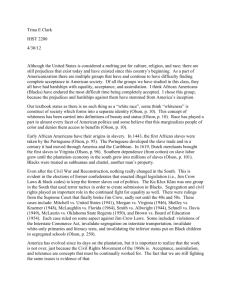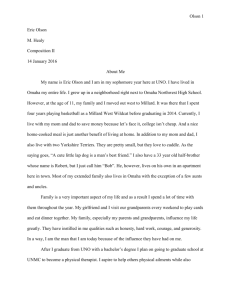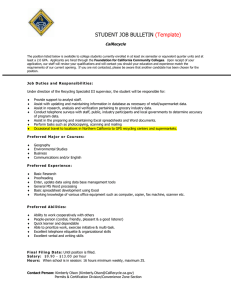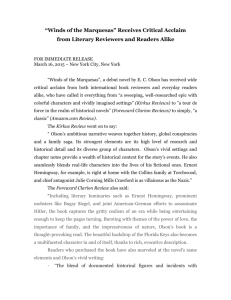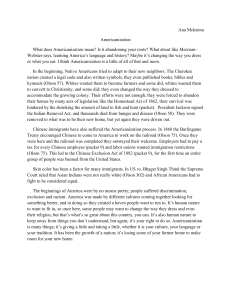Gary M. Olson University of Michigan
advertisement
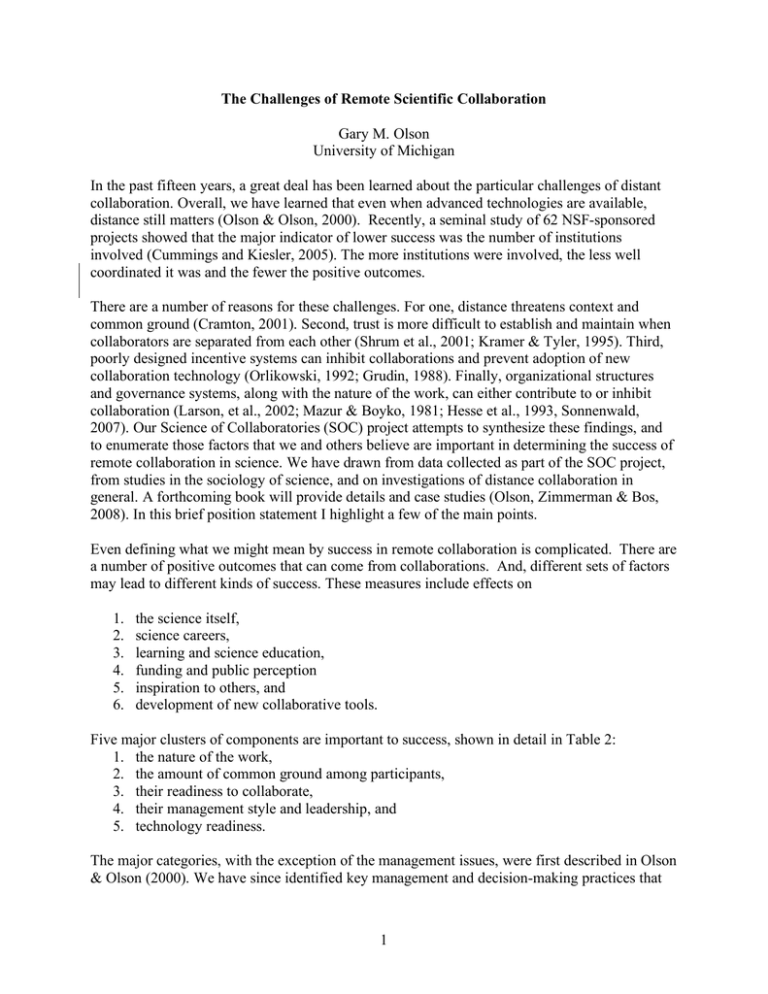
The Challenges of Remote Scientific Collaboration Gary M. Olson University of Michigan In the past fifteen years, a great deal has been learned about the particular challenges of distant collaboration. Overall, we have learned that even when advanced technologies are available, distance still matters (Olson & Olson, 2000). Recently, a seminal study of 62 NSF-sponsored projects showed that the major indicator of lower success was the number of institutions involved (Cummings and Kiesler, 2005). The more institutions were involved, the less well coordinated it was and the fewer the positive outcomes. There are a number of reasons for these challenges. For one, distance threatens context and common ground (Cramton, 2001). Second, trust is more difficult to establish and maintain when collaborators are separated from each other (Shrum et al., 2001; Kramer & Tyler, 1995). Third, poorly designed incentive systems can inhibit collaborations and prevent adoption of new collaboration technology (Orlikowski, 1992; Grudin, 1988). Finally, organizational structures and governance systems, along with the nature of the work, can either contribute to or inhibit collaboration (Larson, et al., 2002; Mazur & Boyko, 1981; Hesse et al., 1993, Sonnenwald, 2007). Our Science of Collaboratories (SOC) project attempts to synthesize these findings, and to enumerate those factors that we and others believe are important in determining the success of remote collaboration in science. We have drawn from data collected as part of the SOC project, from studies in the sociology of science, and on investigations of distance collaboration in general. A forthcoming book will provide details and case studies (Olson, Zimmerman & Bos, 2008). In this brief position statement I highlight a few of the main points. Even defining what we might mean by success in remote collaboration is complicated. There are a number of positive outcomes that can come from collaborations. And, different sets of factors may lead to different kinds of success. These measures include effects on 1. 2. 3. 4. 5. 6. the science itself, science careers, learning and science education, funding and public perception inspiration to others, and development of new collaborative tools. Five major clusters of components are important to success, shown in detail in Table 2: 1. the nature of the work, 2. the amount of common ground among participants, 3. their readiness to collaborate, 4. their management style and leadership, and 5. technology readiness. The major categories, with the exception of the management issues, were first described in Olson & Olson (2000). We have since identified key management and decision-making practices that 1 are important, as well as detailed the significant components within these clusters. Table 1 summarizes the main points about each of these factors. Table 1. Factors that lead to success in Collaboratories 1. The Nature of the Work Participants can work somewhat independently from one another The work is unambiguous Management, Planning and Decision Making, continued A communication plan is in place The plan has room for reflection and redirection No legal issues remain (e.g. IP) No financial issues remain (e.g. money is distributed to fit the work, not politics) A knowledge management system is in place Decision-making is free of favoritism Decisions are based on fair and open criteria Everyone has an opportunity to influence or challenge decisions Leadership sets culture, management plan and makes the collaboratory visible. 2. Common Ground Previous collaboration with these people was successful Participants share a common vocabulary If not, there is a dictionary Participants share a common management or working style 3. Collaboration Readiness The culture is naturally collaborative The goals are aligned in each sub-community Participants have a motivation to work together that includes mix of skills required, greater productivity, they like working together, there is something in it for everyone, NOT a mandate from the funder, the only way to get the money, asymmetries in value, etc. Participants trust each other to be reliable, produce with high quality and have their best interests at heart Participants have a sense of collective efficacy (able to complete tasks in spite of barriers) 5. Technology Readiness Collaboration technologies provide the right functionality and are easy to use If technologies need to be built, user-centered practices are in place Participants are comfortable with the collaboration technologies Technologies give benefit to the participants Technologies are reliable Agreement exists among participants as to what platform to use Networking supports the work that needs to be done Technical support resides at each location An overall technical coordinator is in place 4. Management, Planning and Decision Making The principals have time to do this work The distributed players can communicate with each other in real time more than 4 hours a day There is critical mass at each location There is a point person at each location A management plan is in place The project manager is respected has real PM experience exhibits strong leadership qualities Special issues: If data sharing is one of the goals, defacto standards are in place and shared by all participants, and a plan for archiving is in place If instrument sharing is part of the collaboration, a plan to certify remote users is in place 2 The goals of all collaboratories are to enhance scientific discovery, by having more people coordinate their work, use expensive instruments remotely, and to engage in more creative activity because people from diverse disciplines and backgrounds have come together This is not a trivial thing because of two key tensions: • the greater the diversity the less common ground and trust, which together impede the understanding of each other and the production of new ideas. • the larger the scale, the greater the coordination overhead, increasing exponentially rather than linearly (Brooks, 1995). Standards, management, expectations, etc. all play a role in making these tensions as small as possible: • by finding ways to increase common ground and trust, and • by addressing the coordination problems by good management and decision making and trust. Revolutionary science will come about when scientists can work collectively (many hands make light work) and when diverse points of view are brought to bear on a common problem. Technology, then, has its effect by allowing more diverse and distant groups of scientists to communicate with each other so that their collective work is coordinated (e.g. standards are developed, data aggregated), and that some aspects of the work can be automated or enhanced (e.g., through visualization and computational aids). But coordinating across diversity and distance offers some particular challenges. As the community of scientists grows, management issues loom large (Kraut, Fish, Root, & Chalfonte, 1990). How do we coordinate the various legal and intellectual property issues across the institutions involved? How do we develop standards that satisfy all parties? By the same token, as the diversity of the community grows (e.g. having molecular neuroscientists talking to anatomists to uncover the early signs and perhaps cures of schizophrenia), issues of trust and common ground loom large. How do we assure we are using the same words in the same way? How do we trust the methods of data collection of others who were not trained in the way we were? TORSC highlights these key tradeoffs and points to areas where particular emphasis or new remedial actions are called for. For example, larger and more diverse projects require a more detailed management plan led by experienced project managers, and may call for explicit workshops to engender trust and a common vocabulary. Good management and leadership not only affect internal productivity, but additionally make the project visible. Visibility in turn leads to the possibility of inspiring other scientists, either to work in new ways and even to borrow lessons learned and tools from earlier efforts. Visibility also can lead to public science literacy, and with pressure on Congress, to the possibility of additional funding. We have elaborated on these ideas in a chapter in our forthcoming book (Olson et al, 2008). In a new project, we are building an on-line version of our current interview protocol that will with future collaboratories. It can guide the design of high value technologies; it can provide a framework for conducting evaluations of existing collaborative projects; and it informs strategic planning, concerning with whom to collaborate. 3 Acknowledgements. This work is a collaboration of a larger SOC research group, consisting of many faculty and students at Michigan. The principals have been Judith S. Olson, Ann Zimmerman, and Nathan Bos. References Brooks, F. P. (1995) The Mythical Man-Month: Essays on Software Engineering. Addison-Wesley. Cramton, C. D. (2001). The mutual knowledge problem and its consequences for dispersed collaboration. Organization Science, 12(3), 346-371. Cummings, J., & Kiesler, S. (2005). Collaborative research across disciplinary and institutional boundaries. Social Studies of Science. Grudin, J. (1988). Why CSCW applications fail: Problems in the design and evaluation of organizational interfaces. In Proceedings of the 1988 ACM conference on Computer-supported cooperative work (Portland, OR., September 1998), ACM Press, 85-93. Hesse, B. W., Sproull, L. S., Kiesler, S. B., & Walsh, J. P. (1993). Returns to science: Computer networks in oceanography. Communications of the ACM 36(8), 90-101. Kramer, R. M. & Tyler, T. R. (1995). Trust in Organizations: Frontiers of Theory and Research. Thousand Oaks, CA: Sage Publications. Kraut, R. E., Fish, R., Root, R., & Chalfonte, B. (1990) Informal communication in organizations: Form, function, and technology. In S. Oskamp & S. Spacapan (Eds.) Human reactions to technology: Claremont symposium on applied social psychology. Beverly Hills, CA: Sage Publications. Pp. 145-199. Larson, C., Christian, A., Olson, L., Hicks, D., & Sweeney, C. (2002). The Colorado Trust. Colorado Healthy Communities Initiative: Ten Years Later. Denver, CO: The Colorado Trust. Mazur, A., & Boyko, E. (1981). Large-scale ocean research projects: What makes them succeed or fail? Social Studies of Science, 11, 425-449. Olson, G. M., & Olson, J. S. (2000). Distance matters. Human Computer Interaction, 15, 139-179. Olson, G.M., Zimmerman, A., & Bos, N. (Eds.) (2008) Science on the Internet. Cambridge, MA: MIT Press. Olson, J.S., Hofer, E., Bos, N., Zimmerman, A., Olson, G.M., Cooney, D., & Faniel, I. (2008) A theory of remote scientific collaboration (TORSC). In Olson, G.M., Zimmerman, A., & Bos, N. (Eds.) (2008) Science on the Internet. Cambridge, MA: MIT Press. Orlikowski, W. (1992) Learning from Notes: Organizational issues in groupware implementation. In J. Turner, & R. Kraut (Eds.), Proceedings of the 1992 ACM Conference on Computer-supported Cooperative Work. New York: ACM Press, 362-369. Shrum, W., Chompalov, I., and Genuth, J. (2001). Trust, conflict and performance in scientific collaborations. Social Studies of Science, 31(5), 681-730. Sonnenwald, D. H. (2006) Scientific collaboration: A synthesis of challenges and strategies. Annual Review of Information Science and Technology, Vol 41. B. Cronin (Ed.), Medford, NJ: Information Today. 4
